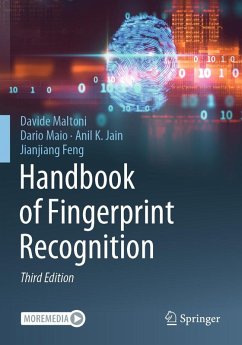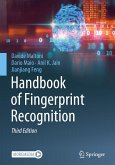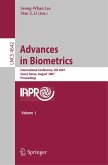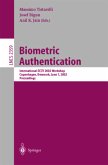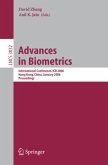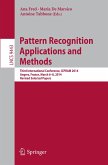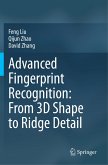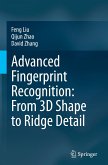With their distinctiveness and stability over time, fingerprints continue to be the most widely used anatomical characteristic in systems that automatically recognize a person's identity.
This fully updated third edition provides in-depth coverage of the state-of-the-art in fingerprint recognition readers, feature extraction, and matching algorithms and applications. Deep learning (resurgence beginning around 2012) has been a game changer for artificial intelligence and, in particular, computer vision and biometrics. Performance improvements (both recognition accuracy and speed) for most biometric modalities can be attributed to the use of deep neural networks along with availability of large training sets and powerful hardware. Fingerprint recognition has also been approached by deep learning, resulting in effective and efficient methods for automated recognition and for learning robust fixed-length representations. However, the tiny ridge details in fingerprints known asminutiae are still competitive with the powerful representations learned by huge neural networks trained on big data.
Features & Benefits:
Reflects the progress made in automated techniques for fingerprint recognition over the past five decadesReviews the evolution of sensing technology: from bulky optical devices to in-display readers in smartphonesDedicates an entire new chapter to latent fingerprint recognition, which is nowadays feasible in "lights-out" modeIntroduces classical and learning-based techniques for local orientation extraction, enhancement, and minutiae detectionProvides an updated review of presentation-attack-detection techniques and their performance evaluationDiscusses the evolution of minutiae matching from rich local descriptors to Minutiae Cylinder Code Presents the development of feature-based matching: from FingerCode to handcrafted textural features to deep featuresReviews fingerprint synthesis, including recent Generative Adversarial Networks
The revised edition of this must-read reference, written by leading international researchers, covers all critical aspects of fingerprint security system design and technology. It is an essential resource for all security and biometrics professionals, researchers, practitioners, developers, and systems administrators, and can serve as an easy-to-read reference for an undergraduate or graduate course on biometrics.
Davide Maltoni is full professor in the Department of Computer Science (DISI) at the University of Bologna, where he also co-directs the Biometrics Systems Laboratory (BioLab).
Dario Maio is full professor in the DISI and a co-director of the BioLab.
Anil K. Jain is university distinguished professor in the Department of Computer Science and Engineering at Michigan State University. Jianjiang Feng is associate professor in the Department of Automation at Tsinghua University.
Hinweis: Dieser Artikel kann nur an eine deutsche Lieferadresse ausgeliefert werden.
This fully updated third edition provides in-depth coverage of the state-of-the-art in fingerprint recognition readers, feature extraction, and matching algorithms and applications. Deep learning (resurgence beginning around 2012) has been a game changer for artificial intelligence and, in particular, computer vision and biometrics. Performance improvements (both recognition accuracy and speed) for most biometric modalities can be attributed to the use of deep neural networks along with availability of large training sets and powerful hardware. Fingerprint recognition has also been approached by deep learning, resulting in effective and efficient methods for automated recognition and for learning robust fixed-length representations. However, the tiny ridge details in fingerprints known asminutiae are still competitive with the powerful representations learned by huge neural networks trained on big data.
Features & Benefits:
Reflects the progress made in automated techniques for fingerprint recognition over the past five decadesReviews the evolution of sensing technology: from bulky optical devices to in-display readers in smartphonesDedicates an entire new chapter to latent fingerprint recognition, which is nowadays feasible in "lights-out" modeIntroduces classical and learning-based techniques for local orientation extraction, enhancement, and minutiae detectionProvides an updated review of presentation-attack-detection techniques and their performance evaluationDiscusses the evolution of minutiae matching from rich local descriptors to Minutiae Cylinder Code Presents the development of feature-based matching: from FingerCode to handcrafted textural features to deep featuresReviews fingerprint synthesis, including recent Generative Adversarial Networks
The revised edition of this must-read reference, written by leading international researchers, covers all critical aspects of fingerprint security system design and technology. It is an essential resource for all security and biometrics professionals, researchers, practitioners, developers, and systems administrators, and can serve as an easy-to-read reference for an undergraduate or graduate course on biometrics.
Davide Maltoni is full professor in the Department of Computer Science (DISI) at the University of Bologna, where he also co-directs the Biometrics Systems Laboratory (BioLab).
Dario Maio is full professor in the DISI and a co-director of the BioLab.
Anil K. Jain is university distinguished professor in the Department of Computer Science and Engineering at Michigan State University. Jianjiang Feng is associate professor in the Department of Automation at Tsinghua University.
Hinweis: Dieser Artikel kann nur an eine deutsche Lieferadresse ausgeliefert werden.
From the reviews:
"...a useful reference for all biometric security professionals and researchers. The four coauthors have a distinguished combination of academic and professional experience....Overall, readers will be pleased with the style and substance of this book." -Computing Reviews
"This is a comprehensive reviews of its topic ... . The thoroughness of the treatment of biometric methods is not obvious from the title. This feature will make the book particularly valuable in some robotics contexts. ... The intended audience includes researchers, practicing engineers, and students ... . The book is suggested as a reference book for a graduate course on biometrics. The material is clearly presented ... . This will certainly be a standard reference work in its field." (Alex M. Andrew, Robotica, Vol. 22, 2004)
"The book is the first reference on automatic fingerprint recognition and provides an in-depth survey of the fingerprint state-of-the-art, presenting the most recent advances in fingerprints ... . is ideally suited to researchers and students in biometrics, pattern recognition, forensics, image processing, and computer vision. In addition, it will be essential to developers of biometric solutions, biometric users ... as well as to project managers and system integrators and administrators involved in the analysis, design, and management of finger-print-based biometric systems." (Computer Spectrum, Issue 4, 2003)
"...a useful reference for all biometric security professionals and researchers. The four coauthors have a distinguished combination of academic and professional experience....Overall, readers will be pleased with the style and substance of this book." -Computing Reviews
"This is a comprehensive reviews of its topic ... . The thoroughness of the treatment of biometric methods is not obvious from the title. This feature will make the book particularly valuable in some robotics contexts. ... The intended audience includes researchers, practicing engineers, and students ... . The book is suggested as a reference book for a graduate course on biometrics. The material is clearly presented ... . This will certainly be a standard reference work in its field." (Alex M. Andrew, Robotica, Vol. 22, 2004)
"The book is the first reference on automatic fingerprint recognition and provides an in-depth survey of the fingerprint state-of-the-art, presenting the most recent advances in fingerprints ... . is ideally suited to researchers and students in biometrics, pattern recognition, forensics, image processing, and computer vision. In addition, it will be essential to developers of biometric solutions, biometric users ... as well as to project managers and system integrators and administrators involved in the analysis, design, and management of finger-print-based biometric systems." (Computer Spectrum, Issue 4, 2003)

